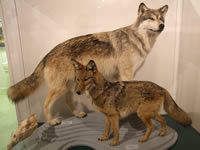Difference between Coyote and Wolf
Key difference: Wolves and coyotes are different species in the same genus, Canis. Coyotes are scavengers, omnivores, and predators of small to medium-sized animals. Wolves are bigger than coyotes and are better adapted to hunt larger animals.
 Wolves and coyotes are different species in the same genus, Canis. Coyotes are scavengers, omnivores, and predators of small to medium-sized animals. Wolves are bigger than coyotes and are better adapted to hunt larger animals.
Wolves and coyotes are different species in the same genus, Canis. Coyotes are scavengers, omnivores, and predators of small to medium-sized animals. Wolves are bigger than coyotes and are better adapted to hunt larger animals.
The wolf is considered as one of the biggest members of the canine family and one of the most popular animals on the planet. It is one of the most well researched animals and probably has the most books written about it. It is the sole and direct ancestor of the dog and hence is able to breed with dogs to produce hybrids. It is currently classified as Least Concern to be extinct or endangered by the International Union for Conservation of Nature (IUCN), despite the fact that they have been despised and persecuted by most humans.
The wolf’s range in now only one third of its original range due to persecution. They are persecuted mainly due to the fact that they are known to feed on livestock, but they rarely attack humans. Still, wolves are most often than not, depicted as evil and malicious in folktales and literature, such as in ‘Little Red Riding Hood’ and the ‘Three Little Pigs.’ However, some Native American tribes have been known to respect and honor the wolf.
Wolves are known for their pack mentality and social structure, with each pack comprising of 8-12 members. These include the alpha male, his mate, who is known as the alpha female, their offspring and the alpha males’ siblings. This pack structure is maintained at all times. The alpha male is the top dog no matter what. He leads the hunts and is responsible for the pack. Wolves are effective pack hunters and are able to effectively communicate and coordinate via scents, howls and facial expressions. There are various species of wolves, but the gray wolf is the most common and most popularly known.
Coyotes are approximately the size of a medium-size dog; however, they tend to have to longer, thicker fur. Coyotes have a long, bushy, black-tipped tail. The tail is usually carried pointing down. Coyotes are most commonly found throughout North and Central America. Their range covers Northern Canada to Panama in the south. They are also known as the American jackal, brush wolf or the prairie wolf. As part of the genus, Canis, coyotes are also able to mate with dogs.
 Coyotes are usually shy of humans and are non-confrontational. They tend to stay away from human habitats. However, as the human population is growing and expanding, humans tend to invade their habitats. Coyotes are extremely territorial and hence will confront the humans. As the chance encounters between humans and coyotes increase, coyotes are slowly loosing their fear of humans. However, coyotes rarely attack prey bigger than themselves; hence most adult humans are safe. Coyotes tend to pose more of a threat to livestock, such as sheep and chicken, and in some rare cases to human children and babies. These instances have led to prosecution of coyotes. Still, coyotes are currently classified as Least Concern to be extinct or endangered by the International Union for Conservation of Nature (IUCN).
Coyotes are usually shy of humans and are non-confrontational. They tend to stay away from human habitats. However, as the human population is growing and expanding, humans tend to invade their habitats. Coyotes are extremely territorial and hence will confront the humans. As the chance encounters between humans and coyotes increase, coyotes are slowly loosing their fear of humans. However, coyotes rarely attack prey bigger than themselves; hence most adult humans are safe. Coyotes tend to pose more of a threat to livestock, such as sheep and chicken, and in some rare cases to human children and babies. These instances have led to prosecution of coyotes. Still, coyotes are currently classified as Least Concern to be extinct or endangered by the International Union for Conservation of Nature (IUCN).
Furthermore, some cultures such as Native American, First Nations, and Aboriginal feature a deity whose name is translated into English as "Coyote" in their traditional stories. Coyote often appears in creation myths and etiological myths, usually as a trickster, a culture hero or both.
A detailed comparison between the wolf and coyote:
|
|
Coyote |
Wolf |
|
Scientific classification |
Animalia – Chordata – Mammalia – Carnivora – Canidae – Canis |
Animalia – Chordata – Mammalia – Carnivora – Canidae – Canis |
|
Species |
Canis latrans 19 subspecies: 16 in Canada, Mexico and the United States, and three in Central America |
Grey wolf: C. lupus Mexican wolf: C. l. baileyi; Red wolf: C. rufus. |
|
Indigenous |
Throughout North and Central America. |
Throughout the Northern Hemisphere, mainly North America |
|
Description |
Gray or reddish-gray with light yellow or white legs, feet, ears, throat, and chest. The tail is bushy with a black tip. Grows up to two feet (60 cm) tall and weighs 20 to 40 pounds (9 to 18 kg). Very fast runner, keen vision and an excellent sense of smell. A distinctive feature of the coyote is its mournful howl. Very adaptive and can live almost anywhere. Typically grow to 30–34 in (76–86 cm) in length, not counting a tail of 12–16 in (30–41 cm), stand about 23–26 in (58–66 cm) at the shoulder and weigh from 15–46 lb (6.8–21 kg). Are generally shy and non-confrontational. |
Skillful hunter with a keen sense of smell, acute hearing, and great stamina. 26 to 38 inches (66 to 97 cm) high at the shoulder and up to 80 inches (2 m) long, including a 14- to 20-inch (36- to 50-cm) tail. It weighs 60 to 130 pounds (27 to 59 kg). Hunt and live in packs for 8-12 members. Very territorial. Have sharp canine teeth and very strong jaws. |
|
Howls |
Short howls, varying in pitch. More like yips than howls. Used for communicating with others. |
Long howls, various howls as means of conversing with other members. |
|
Fur |
Grayish-brown to yellowish-gray on the upper parts, while the throat and belly tend to have a buff or white color. |
Typically light gray sprinkled with black but can range from nearly pure white, red, or brown to black. |
|
Muzzle |
Smaller and pointed |
Large and squared |
|
Ears |
Pointed, relatively long |
Rounded, relatively short |
|
Speed |
May reach speeds up to 43 mph (69 km/h), and can jump a distance of over 13 ft (4 m). |
Can run for 12 miles at 15 to 30 miles (24 to 48 kilometers) per hour. Over a short distance, it can sprint as fast as 40 miles (64 kilometers) per hour. |
|
Dens |
In burrows or dens in the ground. |
In caves, in hollow logs, or in burrows in stream banks or sandy knolls |
|
Food |
Mainly of small rodents, insects, fruit, carrion, and fish. Will attack livestock when other prey is scarce. |
Moose, caribou, deer, small rodents, birds, insects, crayfish, and berries. |
|
Mating habits |
Mated pair may remain temporarily monogamous for a number of years, and then change mates. |
Wolves usually mate for life and both parents take care of the young. |
|
Gestation period |
60 to 63 days |
63 days |
|
Litter |
One litter per year: one to 19 pups. On average six. |
Four to seven pups |
Image Courtesy: fwp.mt.gov, flickr.com









Comments
Annon
Wed, 01/24/2018 - 13:44
Add new comment